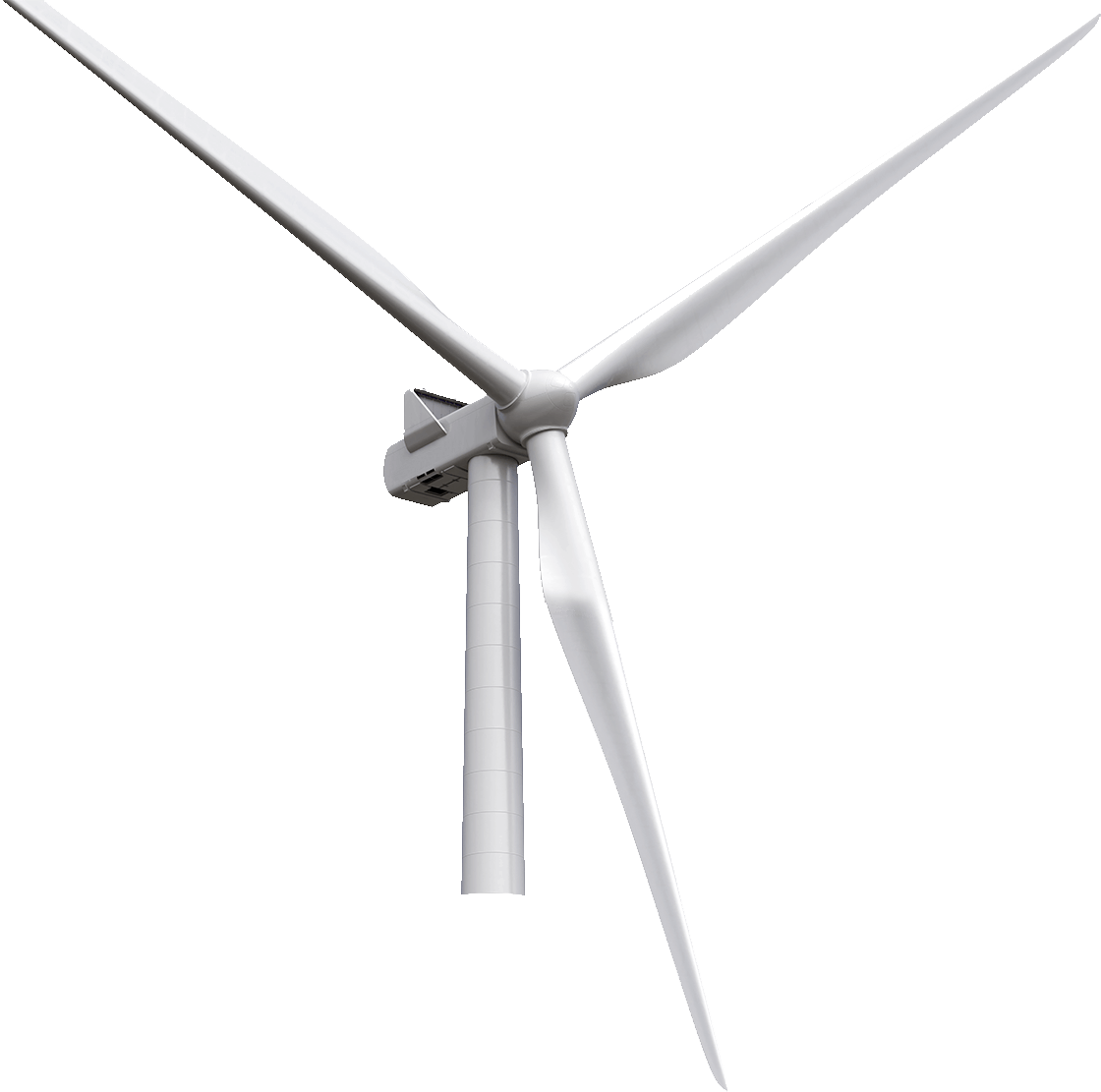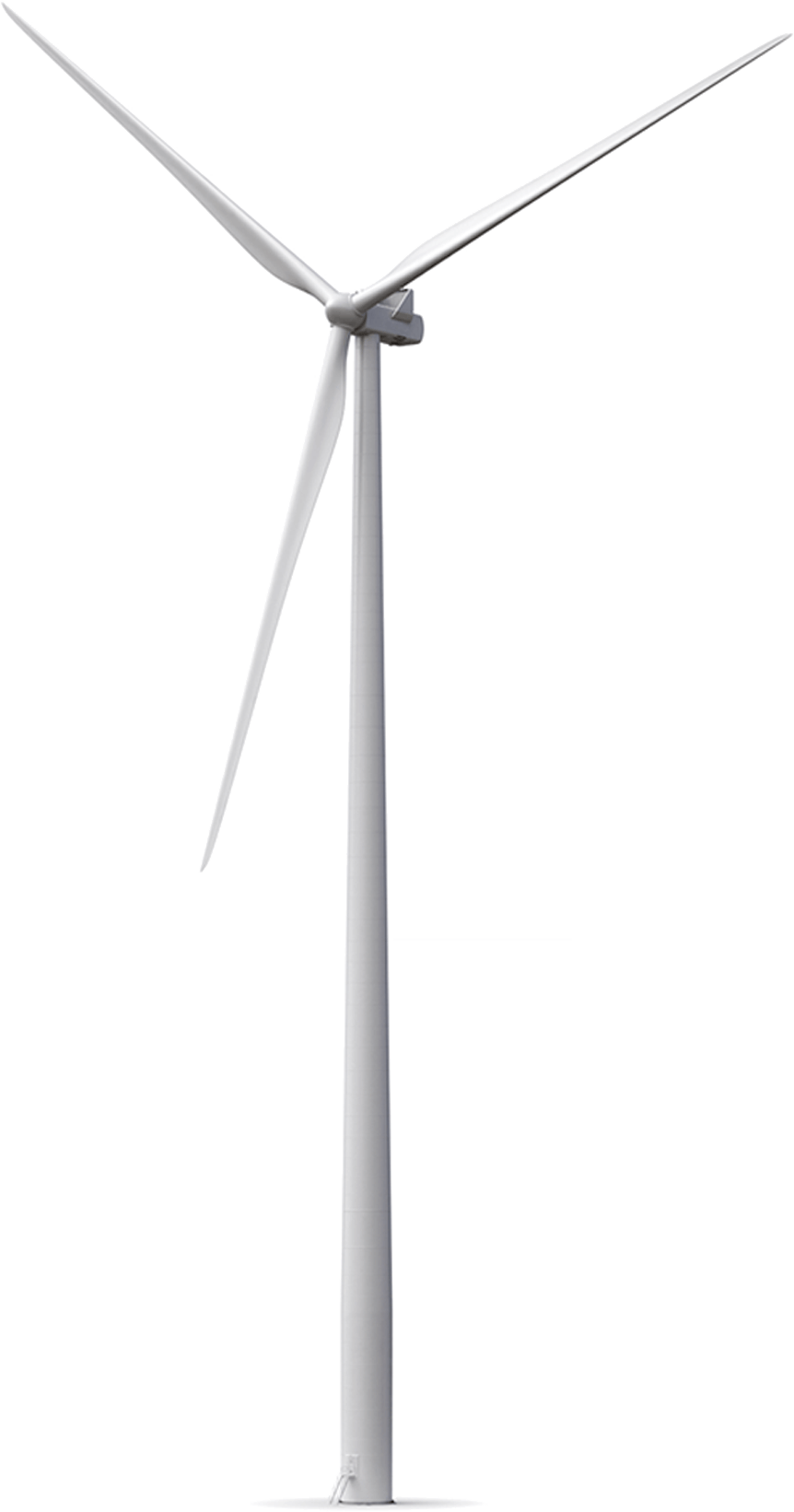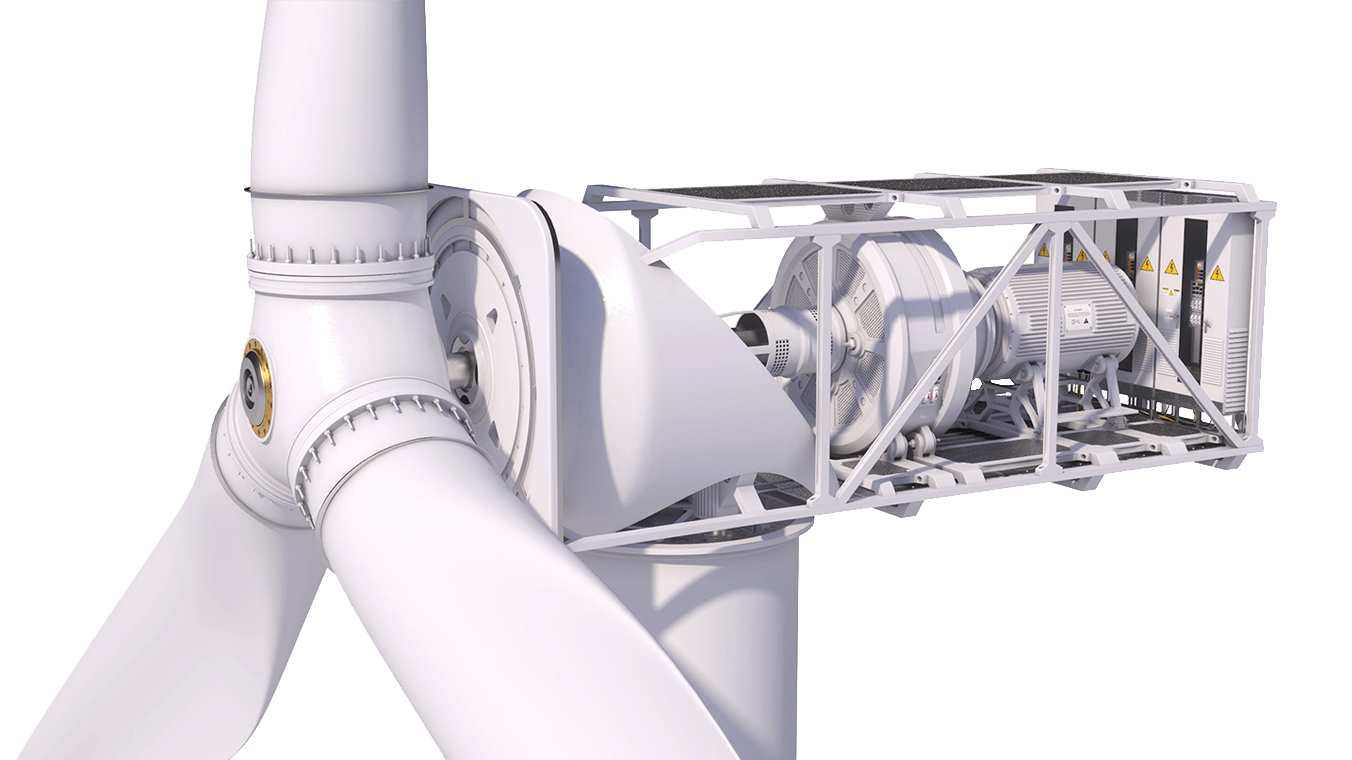Wind Energy
A wind turbine transforms wind energy into electrical energy.
Learn more
A wind turbine transforms wind energy into electrical energy.
The wind rotates the three blades of the rotor. This drives a generator, which is located in the nacelle, producing electricity.

300 km/h
Is the speed at the end of the blade at standard power levels. In one week, the distance covered is equivalent to a trip around the world!
5.6 MW
Today, the latest onshore wind turbine models can produce up to 5.6 MW of power.
3500
Is the number of households a latest generation wind turbine can supply with electricity each year.
Rotor
The rotor consists of three blades, which can be up to 75 metres in length, and a hub. The rotor converts kinetic energy from the wind into mechanical energy. A generator inside the wind turbine then converts it to electrical energy, which is then converted to be fed into the grid.
Nacelle
This is located on top of the tower and contains the gearbox, low and high-speed shafts, the generator, the controller and the brake. The nacelle houses all the elements a wind turbine uses to operate on a daily basis.
Tower
The tower is made of steel and houses the electrical control system and the transformer. The tower supports the nacelle structure and is up to 130 metres in height. As wind speed increases with height, the highest towers can capture more energy and generate more electricity. At the bottom of the tower, there is a door that provides access up the wind turbine and into the nacelle.
Foundation
The foundation of a wind turbine is made of solid reinforced concrete with a diameter of 22-25 metres – depending on the wind turbine type and any geotechnical constraints – and is 2.5-4.4 metres deep.

Rotor
Nacelle
Tower
Foundation
01
02
03

Gearbox
The gearbox increases the rotational speed of the shaft to 1,500 rpm.
Alternator
The alternator produces the electrical current.
Transformer
The transformer increases electrical current voltage produced by the alternator to transport electricity in medium-voltage lines in the grid.
When the wind blows, it causes the three blades of the rotor to rotate, transforming its energy into mechanical energy. This energy is then transmitted to the generator, which is located in the nacelle, which, in turn, produces electricity.
In order to transport the generated energy afterwards, a transformer is located inside the tower and increases the voltage of the electrical current so that it can be transported more easily in the medium-voltage lines of the electrical grid.
The electricity is then transported via buried cables that connect the wind turbines in a given wind farm to a substation that collects all the energy produced. From there, energy is routed to the public grid, again via underground cables.
Wind energy, along with solar energy, is one of the so-called “green” energies. It uses energy from the wind outside to generate electricity, making it a natural, renewable and inexhaustible resource.
Unlike other energy sources, wind turbines do not emit greenhouse gases, produce toxic waste or generate air pollution. The process also does not involve the extraction of any raw materials, which would have a major impact on the environment, and is not linked to any health issues. It is a technology that is controlled from start to finish.
Wind energy is one of the key solutions to combatting global warming.
In 2019, the proportion of wind energy in the energy mix was 6.3%.
Since 18 August 2015 and the entry into force of the Green Energy Transition Act, France has set a goal of achieving 32% of energy consumed being renewable by 2030.
Long-term targets were also set in 2018 by the Multiannual Energy Plan (PPE). For onshore wind turbines, installed capacity will be 24.6 GW by the end of 2023 and 34.1 GW by 2028.
In 2020, the cost of generating wind power is about half that of nuclear power. The fifth call for tenders for wind turbines showed that the average production price was €62.2/MWh, compared with an estimated cost of between €110 and €120/MWh for the latest EPR nuclear reactors (French National Court of Auditors, 2019).
The production costs of this relatively new technology continue to fall as the industry matures, unlike nuclear technology, which often underestimates safety and decommissioning costs.
It should be noted that the financial guarantees for dismantling a wind farm are already covered before construction begins and are unlikely to vary.
The development of wind farms has always been subject to numerous controversies relating to the variability and efficiency of the process. While it is clear that wind power is a variable energy resource, its production capacity, technological innovations, and its predictability over a period of several days, make it a reliable source of energy that provides better electrical stability in the French energy mix. By distributing wind turbine production potential across the country in conjunction with other means of producing renewable energy, continuous and controlled power production can be achieved, with the understanding that in cases of oversupply, wind turbine production can be restricted.
Wind turbines are subject to the legislation on facilities requiring environmental impact assessments (ICPE) with very strict noise emission requirements.
There are two sources of noise in a wind turbine: the mechanically generated noise created by the different moving parts of the machinery inside the nacelle, and the aerodynamic noise, which is caused by wind blowing into the blades. In both cases, technological advancements have made it possible to reduce these noise emissions significantly compared to first-generation wind turbines. This is mainly due to optimised blade design, the composite materials used, and the use of silenced precision gears and damping bushings in the machines.
Wind turbines must be located more than 500 metres from any dwelling, making their noise emissions extremely unobtrusive.
Wind turbine noise produces 30 dB(A), which is the sound equivalent of noise in a bedroom, i.e. well below noise levels from a window overlooking a street (60 dB(A)) or inside a classroom (70 dB(A)).
French law requires that wind farms do not exceed ambient noise levels by +3 dB at night and +5 dB during the day.
The law strictly regulates the placement of wind turbines through stringent requirements and compulsory advanced design obligations, so as to avoid, reduce or offset any impact on the human, natural or heritage environment.
Each project must meet protection zone requirements with regard to certain elements such as dwellings, easements, natural areas of interest, transport and telecommunications networks, etc.
Starting a wind turbine project is a relatively lengthy process (5-10 years) due to the extensive studies and careful reviews required.
In France, bird mortality is estimated by the French League for the Protection of Birds (LPO) to be between 6.6 and 7.2 birds per year, per wind turbine.
It should be noted that road traffic, power lines, buildings and cats cause far more victims among birds than wind turbines.
The environmental studies provided for by law make it possible to assess situations on a case-by-case basis. The projects can then be adapted to take into account the behaviour of species on the site on the basis of the results of the studies. Additional measures, such as restricting wind turbine use during periods of high activity or sound-emitting systems that repulse birds or bats from the area, help to maintain negligible impact levels. Planting hedges, establishing wildlife set-asides and grassy areas, as well as developing forest areas, will allow birdlife to recover reproduction and hunting areas.
Furthermore, the construction phases are carefully planned so that wildlife reproduction periods are not disrupted.